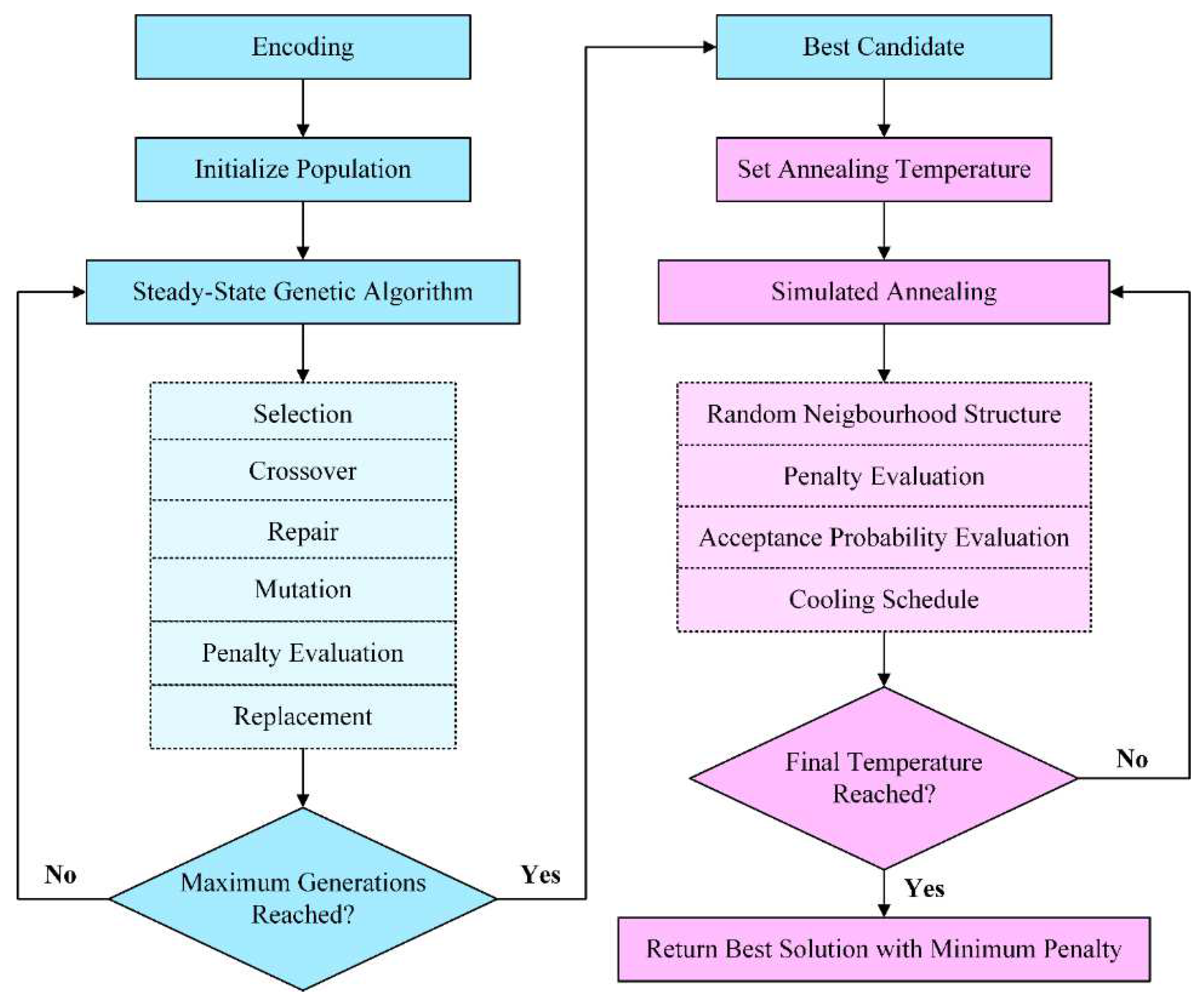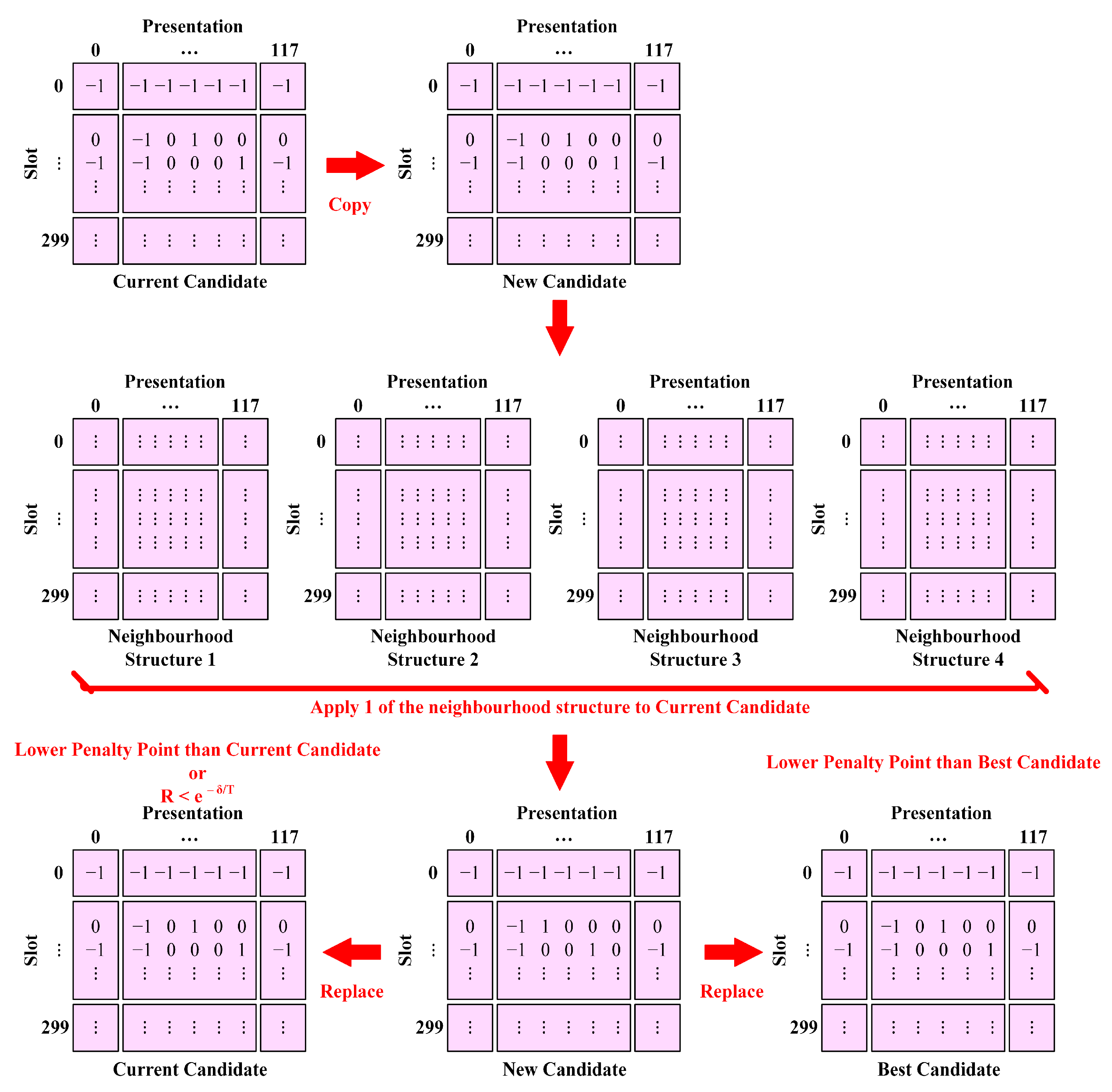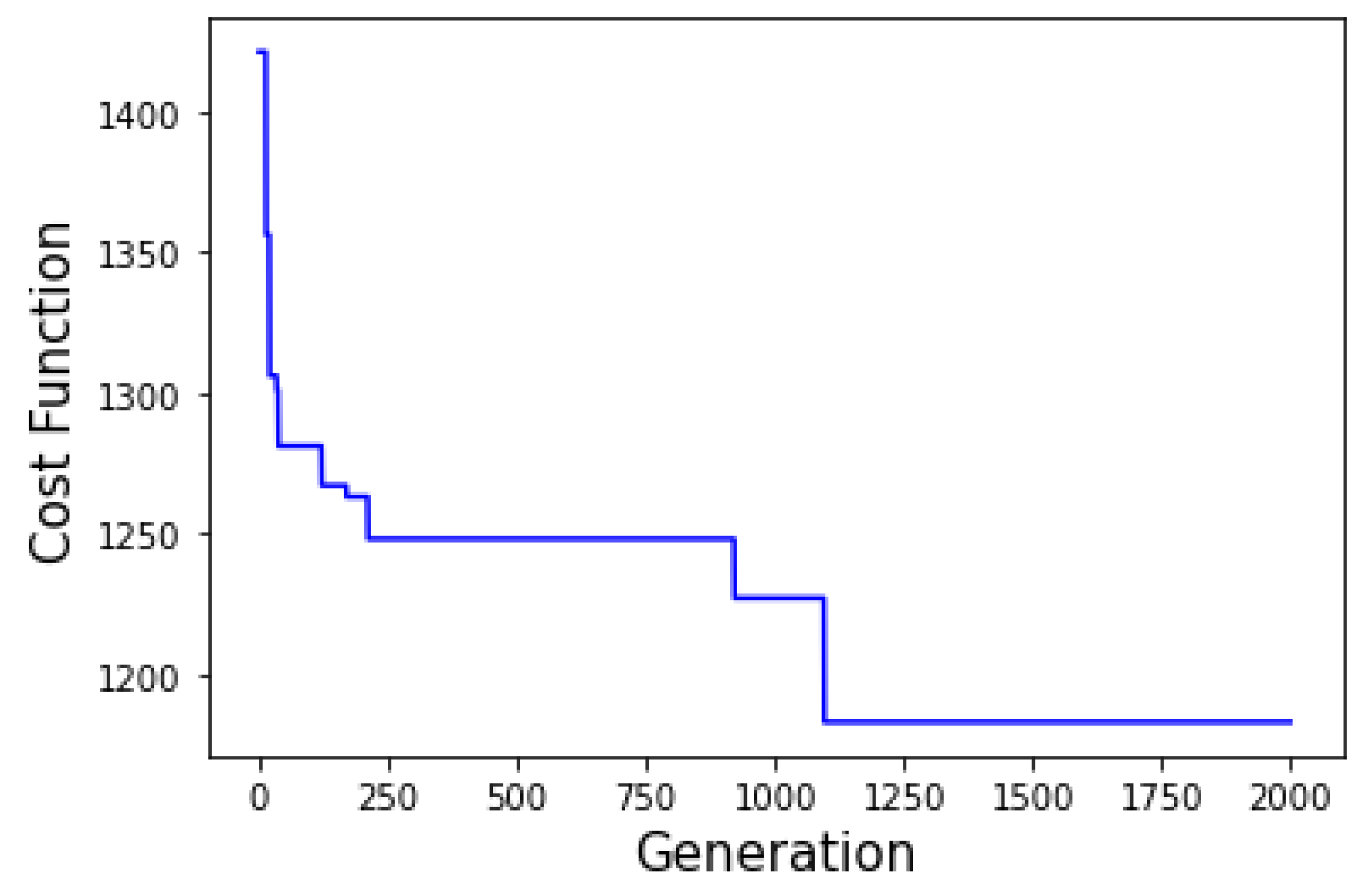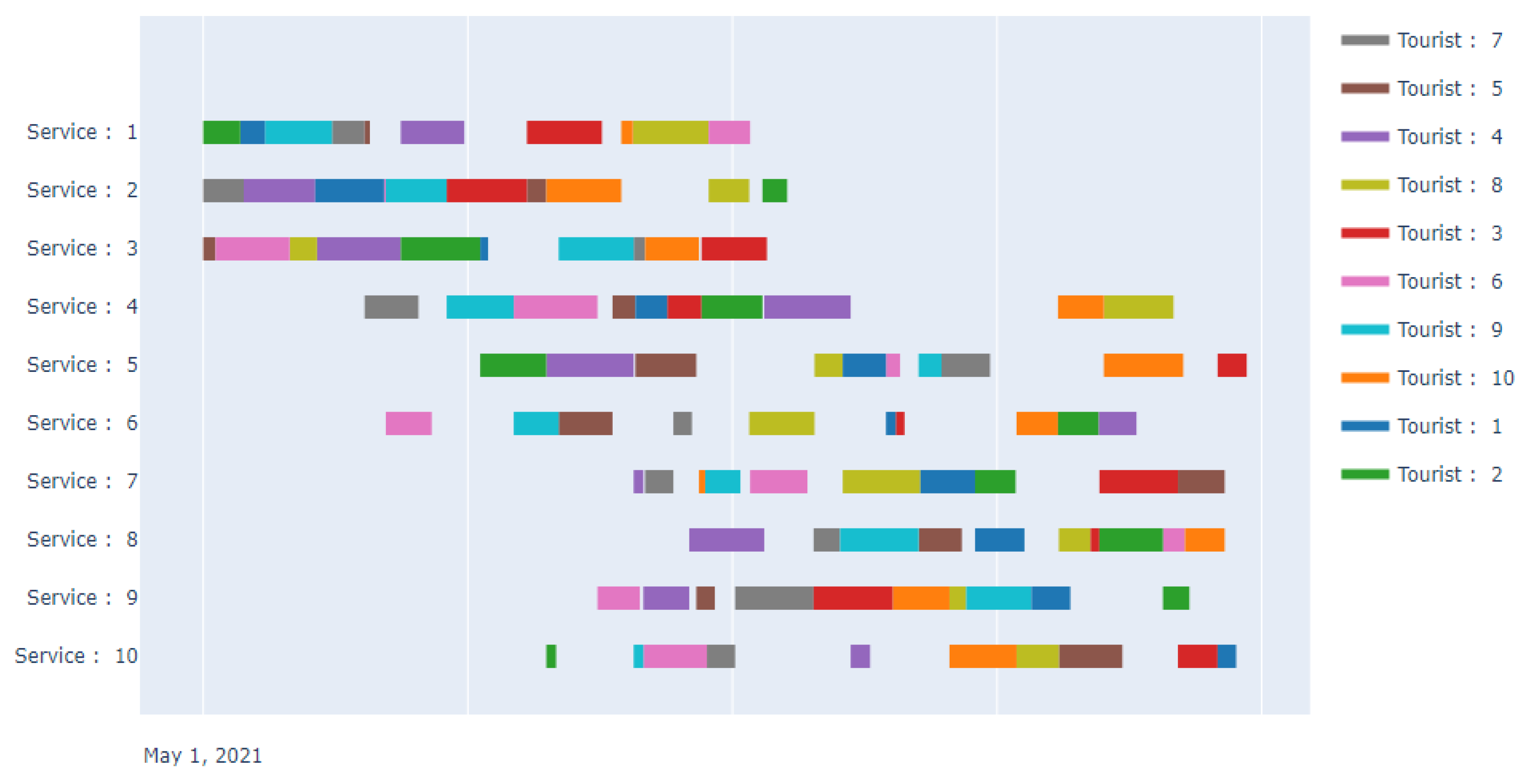Tourism Service Scheduling in Smart City Based on Hybrid Genetic Algorithm Simulated Annealing Algorithm
Abstract
1. Introduction
2. Materials and Methods
2.1. Tourism Pacagke Tours and Service Scheduling
2.2. Tourism Service Scheduling in Smart City
2.3. Hybrid Genetic Algorithm
2.4. Simulated Annealing Algorithm
3. Methodology
3.1. Simulated Annealing Algorithm
Problem Definition
- given tourists n, N = {j1, j2, …, jn};
- given tourists consists of s operations S = {Oj1, Oj2, …, Oj,s}.
s = 1, 2, …, sj
s = 1, 2, …, sj
3.2. The Proposed Hybrid Genetic Algorithm-Simulated Annealing Algorithm
3.3. Encoding and Decoding
3.4. The Knowledge-Based Operator and the Fitness Function
3.5. Encoding Selection Operator
3.6. Crossover
3.7. Mutation
4. Results
4.1. Simulated Annealing
4.2. Ending Conditions
4.3. Computational Experiments and Discussion
5. Conclusions and Discussion
Author Contributions
Funding
Institutional Review Board Statement
Informed Consent Statement
Data Availability Statement
Acknowledgments
Conflicts of Interest
References
- AuPinedo, M.L. Introduction. In Scheduling: Theory, Algorithms, and Systems; Springer: New York, NY, USA, 2012; pp. 1–10. [Google Scholar]
- Garey, M.R.; Johnson, D.S.; Sethi, R. The complexity of flowshop and jobshop scheduling. Math. Oper. Res. 1976, 1, 117–129. [Google Scholar] [CrossRef]
- Ullman, J.D. NP-complete scheduling problems. J. Comput. Syst. Sci. 1975, 10, 384–393. [Google Scholar] [CrossRef]
- Carlier, J.; Pinson, E. An algorithm for solving the job-shop problem. Manag. Sci. 1989, 35, 164–176. [Google Scholar] [CrossRef]
- Adams, J.; Balas, E.; Zawack, D. The shifting bottleneck procedure for job shop scheduling. Manag. Sci. 1988, 34, 391–401. [Google Scholar] [CrossRef]
- Vancheeswaran, R.; Townsend, M.A. Two-stage heuristic procedure for scheduling job shops. J. Manuf. Syst. 1993, 12, 315–325. [Google Scholar] [CrossRef]
- Brucker, P.; Jurisch, B.; Sievers, B. A branch and bound algorithm for the job-shop scheduling problem. Discret. Appl. Math. 1994, 49, 107–127. [Google Scholar] [CrossRef]
- Lageweg, B.J.; Lenstra, J.K.; Rinnooy Kan, A.H. Job-shop scheduling by implicit enumeration. Manag. Sci. 1977, 24, 441–450. [Google Scholar] [CrossRef]
- Fisher, H.; Thompson, G.L. Probabilistic Learning Combinations of Local Job-Shop Scheduling Rules; Prentice-Hall: Englewood Cliffs, NJ, USA, 1963. [Google Scholar]
- Qing-Dao-Er-Ji, R.; Wang, Y.; Wang, X. Inventory based two-objective job shop scheduling model and its hybrid genetic algorithm. Appl. Soft Comput. 2013, 13, 1400–1406. [Google Scholar] [CrossRef]
- Croce, F.D.; Tadei, R.; Volta, G. A genetic algorithm for the job shop problem. Comput. Oper. Res. 1995, 22, 15–24. [Google Scholar] [CrossRef]
- Zhang, J.; Hu, X.; Tan, X.; Zhong, J.H.; Huang, Q. Implementation of an ant colony optimization technique for job shop scheduling problem. Trans. Inst. Meas. Control 2006, 28, 93–108. [Google Scholar] [CrossRef]
- Zhang, J.; Zhang, P.; Yang, J.; Huang, Y. Solving the Job Shop Scheduling Problem using the imperialist competitive algorithm. Adv. Mater. Res. 2012, 845, 737–740. [Google Scholar] [CrossRef]
- Piroozfard, H.; Wong, K.Y. An imperialist competitive algorithm for the job shop scheduling problems. In Proceedings of the IEEE International Conference on Industrial Engineering and Engineering Management (IEEM ’14), Selangor, Malaysia, 9–12 December 2014; pp. 69–73. [Google Scholar]
- Armentano, V.A.; Scrich, C.R. Tabu search for minimizing total tardiness in a job shop. Int. J. Prod. Econ. 2000, 63, 131–140. [Google Scholar] [CrossRef]
- Rakkiannan, T.; Palanisamy, B. Hybridization of genetic algorithm with parallel implementation of simulated annealing for job shop scheduling. Am. J. Appl. Sci. 2012, 9, 1694–1705. [Google Scholar]
- Zhang, R.; Wu, C. A hybrid immune simulated annealing algorithm for the job shop scheduling problem. Appl. Soft Comput. J. 2010, 10, 79–89. [Google Scholar] [CrossRef]
- Lei, D. A Pareto archive particle swarm optimization for multi-objective job shop scheduling. Comput. Ind. Eng. 2008, 54, 960–971. [Google Scholar] [CrossRef]
- Coello, C.A.C.; Rivera, D.C.; Cortés, N. Use of an artificial immune system for job shop scheduling. In Artificial Immune Systems; Timmis, J., Bentley, P., Hart, E., Eds.; Springer: Berlin/Heidelberg, Germany, 2003; pp. 1–10. [Google Scholar]
- Jain, A.S.; Meeran, S. Deterministic job-shop scheduling: Past, present and future. Eur. J. Oper. Res. 1999, 113, 390–434. [Google Scholar]
- Çaliş, B.; Bulkan, S. A research survey: Review of AI solution strategies of job shop scheduling problem. J. Intell. Manuf. 2015, 26, 961–973. [Google Scholar] [CrossRef]
- Holland, J.H. Genetic algorithms. Sci. Am. 1992, 267, 66–72. [Google Scholar] [CrossRef]
- Davis, L. Job shop scheduling with genetic algorithms. In Proceedings of the 1st International Conference on Genetic Algorithms, Hillsdale, NJ, USA, 1 July 1985; pp. 136–140. [Google Scholar]
- Yamada, T.; Nakano, R. A genetic algorithm applicable to large-scale job-shop problems. In Proceedings of the Parallel Problem Solving from Nature (PPSN-II ’92), Brussels, Belgium, 28–30 September 1992; Elsevier Science: Amsterdam, The Netherlands, 1992; pp. 281–290. [Google Scholar]
- Lee, K.M.; Yamakawa, T.; Lee, K.M. Genetic algorithm for general machine scheduling problems. In Proceedings of the 1998 Second International Conference. Knowledge-Based Intelligent Electronic Systems. Proceedings KES’98 (Cat. No.98EX111), Adelaide, SA, Australia, 21–23 April 1998; Volume 2, pp. 60–66. [Google Scholar] [CrossRef]
- Sun, L.; Cheng, X.; Liang, Y. Solving job shop scheduling problem using genetic algorithm with penalty function. Int. J. Intell. Inf. Process. 2010, 1, 65–77. [Google Scholar]
- Wang, L.; Zheng, D.Z. An effective hybrid optimization strategy for job-shop scheduling problems. Comput. Oper. Res. 2001, 28, 585–596. [Google Scholar] [CrossRef]
- Zhou, H.; Feng, Y.; Han, L. The hybrid heuristic genetic algorithm for job shop scheduling. Comput. Ind. Eng. 2001, 40, 191–200. [Google Scholar] [CrossRef]
- Ombuki, B.M.; Ventresca, M. Local search genetic algorithms for the job shop scheduling problem. Appl. Intell. 2004, 21, 99–109. [Google Scholar] [CrossRef]
- Gonçalves, J.F.; Mendes, J.J.D.M.; Resende, M.G.C. A hybrid genetic algorithm for the job shop scheduling problem. Eur. J. Oper. Res. 2005, 167, 77–95. [Google Scholar] [CrossRef]
- Lin, L.; Yugeng, X. A hybrid genetic algorithm for job shop scheduling problem to minimize makespan. In Proceedings of the 2006 6th World Congress on Intelligent Control and Automation, Dalian, China, 21–23 June 2006; pp. 3709–3713. [Google Scholar] [CrossRef]
- Zhou, H.; Cheung, W.; Leung, L.C. Minimizing weighted tardiness of job-shop scheduling using a hybrid genetic algorithm. Eur. J. Oper. Res. 2009, 194, 637–649. [Google Scholar] [CrossRef]
- Asadzadeh, L.; Zamanifar, K. An agent-based parallel approach for the job shop scheduling problem with genetic algorithms. Math. Comput. Model. 2010, 52, 1957–1965. [Google Scholar] [CrossRef]
- Yusof, R.; Khalid, M.; Hui, G.T.; Md Yusof, S.; Othman, M.F. Solving job shop scheduling problem using a hybrid parallel micro genetic algorithm. Appl. Soft Comput. J. 2011, 11, 5782–5792. [Google Scholar] [CrossRef]
- Kirkpatrick, S.; Gelatt, C.D., Jr.; Vecchi, M.P. Optimization by simulated annealing. Science 1983, 220, 671–680. [Google Scholar] [CrossRef]
- Enoch, Y. Contents of tour packages: A cross-cultural comparison. Ann. Tour. Res. 1996, 23, 599–616. [Google Scholar] [CrossRef]
- March, R. The Japanese travel life cycle. J. Travel Tour. Mark. 2000, 9, 185–200. [Google Scholar] [CrossRef]
- Seddighi, H.R.; Theocharous, A.L. A model of tourism destination choice: A theoretical and empirical analysis. Tour. Manag. 2002, 23, 475–487. [Google Scholar] [CrossRef]
- Wang, K.C.; Hsieh, A.T.; Chou, S.H.; Lin, Y.S. GPTCCC: An instrument for measuring group package tour service. Tour. Manag. 2007, 28, 361–376. [Google Scholar] [CrossRef]
- Seddighi, H. Does cultural background of tourists influence the destination choice? an empirical study with special reference to political instability. Tour. Manag. 2001, 22, 181–191. [Google Scholar] [CrossRef]
- Theuvsen, L. Vertical integration in the European package tour business. Ann. Tour. Res. 2004, 31, 475–478. [Google Scholar] [CrossRef]
- Chen, Y.; Mak, B.; Li, Z. Quality deterioration in package tours: The interplay of asymmetric information. Tour. Manag. 2013, 38, 43–54. [Google Scholar] [CrossRef]
- Alao, O.; Batabyal, A.A. Selling package tours to tourists: A contract theory perspective. Ann. Tour. Res. 2013, 42, 439–442. [Google Scholar] [CrossRef]
- Aguiar-Quinatna, T.; Moreno-Gil, S.; Patricia-Peral, P. How could traditional travel agencies improve their competitiveness and survive? A qualitative study in Spain. Tour. Manag. 2016, 20, 98–108. [Google Scholar]
- Reay, P.; Seddighi., H. An empirical evaluation of management and operational capabilities for innovation via co-creation. European. J. Innov. Manag. 2012, 15, 259–275. [Google Scholar] [CrossRef]
- Nuray, A.; Theuvsen, L. Organic agriculture in Turkey: Status, achievements, and shortcomings. Organ. Agric. 2021, 11, 501–507. [Google Scholar] [CrossRef]
- Jin, L.; He, Y.; Song, H. Service customization: To upgrade or to downgrade? An investigation of how option framing affects tourists’ choice of package-tour service. Tour. Manag. 2012, 33, 266–275. [Google Scholar] [CrossRef]
- Chen, H.; Weiler, B.; Young, M. Examining service shortfalls: A case study of Chinese group package tours to Australia. J. Vacat. Market. 2018, 24, 371–386. [Google Scholar] [CrossRef]
- Batabyal, A.A.; Yoo, S.J. A probabilistic analysis of guided tours for tourists during the slack season. Tour. Manag. 2010, 31, 482–485. [Google Scholar] [CrossRef]
- Jørgensen, F.; Solvoll, G. Demand models for inclusive tour charter: The Norwegian case. Tour. Manag. 1996, 17, 17–24. [Google Scholar] [CrossRef]
- Tepelus, C. Aiming for sustainability in the tour operating business. J. Clean. Prod. 2005, 13, 99–107. [Google Scholar] [CrossRef]
- Arabani, A.B.; Farahani, R.Z. Facility location dynamics: An overview of classifications and applications. Comput. Ind. Eng. 2012, 62, 408–420. [Google Scholar] [CrossRef]
- Luan, J.; Yao, Z.; Zhao, F.; Song, X. A novel method to solve supplier selection problem: Hybrid algorithm of genetic algorithm and ant colony optimization. Math. Comput. Simul. 2019, 76, 294–309. [Google Scholar] [CrossRef]
- Niknamfar, A.H.; Niaki, S.T.A. A binary-continuous invasive weed optimization algorithm for a vendor selection problem. Knowl. Based Syst. 2018, 140, 158–172. [Google Scholar] [CrossRef]
- Tyan, I.; Yagüe, M.I.; Guevara-Plaza, A. Blockchain Technology for Smart Tourism Destinations. Sustainability 2021, 12, 9715. [Google Scholar] [CrossRef]
- Koo, C.; Park, J.; Lee, J.N. Smart tourism: Traveler, business, and organizational perspectives. Inf. Manag. 2017, 54, 683–686. [Google Scholar] [CrossRef]
- Taweesaengsakulthai, S.; Laochankham, S.; Kamnuansilpa, P.; Wongthanavasu, S. Thailand Smart Cities: What is the Path to Success? Asian Politics Policy 2019, 11, 144–156. [Google Scholar] [CrossRef]
- Chen, R.C.; Wang, H.L. Application of Genetic Algorithm to Scheduling of Tour Guides for Tourism and Leisure Industry. INFOS Cairo-Egypt 2008, 43, 4083–4101. [Google Scholar] [CrossRef]
- Thumrongvut, P.; Sethanan, K.; Pitakaso, R.; Jamrus, T.; Golinska-Dawson, P. Application of Industry 3.5 approach for planning of more sustainable supply chain operations for tourism service providers. Int. J. Logist. Res. Appl. 2022, 1–24. [Google Scholar] [CrossRef]
- Li, X.; Yin, M. An opposition-based differential evolution algorithm for permutation flow shop scheduling based on diversity measure. Adv. Eng. Softw. 2013, 55, 10–31. [Google Scholar] [CrossRef]
- Hassanat, A.B.; Prasath, V.B.S.; Abbadi, M.A.; Abu-Qdari, S.A.; Faris, H. An improved genetic algorithm with a new initialization mechanism based on Regression techniques. Information 2018, 9, 167. [Google Scholar] [CrossRef]
- Lee, T.S.; Loong, Y.T. A review of scheduling problem and resolution methods in flexible flow shop. Int. J. Ind. Eng. Comput. 2019, 10, 67–88. [Google Scholar] [CrossRef]
- Tosun, Ö.; Marichelvam, M.K.; Tosun, N. A literature review on hybrid flow shop scheduling. Int. J. Adv. Oper. Manag. 2020, 12, 156–194. [Google Scholar] [CrossRef]
- Ben Cheikh-Graiet, S.; Dotoli, M.; Hammadi, S. A tabu search based metaheuristic for dynamic carpooling optimization. Comput. Ind. Eng. 2020, 140, 106217. [Google Scholar] [CrossRef]
- Deng, G.; Wei, M.; Su, Q.; Zhao, M. An effective co-evolutionary quantum genetic algorithm for the no-wait flow shop scheduling problem. Adv. Mech. Eng. 2015, 7, 1687814015622900. [Google Scholar] [CrossRef]
- Wei, H.; Li, S.; Jiang, H.; Hu, J.; Hu, J.J. Hybrid genetic simulated annealing algorithm for improved flow shop scheduling with makespan criterion. Appl. Sci. 2018, 8, 2621. [Google Scholar] [CrossRef]
- Tasgetiren, M.F.; Kizilay, D.; Pan, Q.K.; Suganthan, P.N. Iterated greedy algorithms for the blocking flowshop scheduling problem with makespan criterion. Comput. Oper. Res. 2017, 77, 111–126. [Google Scholar] [CrossRef]
- Wang, C.-N.; Yang, F.-C.; Nguyen, V.T.T.; Vo, N.T.M. CFD Analysis and Optimum Design for a Centrifugal Pump Using an Effectively Artificial Intelligent Algorithm. Micromachines 2022, 13, 1208. [Google Scholar] [CrossRef]
- Abualigah, L.; Yousri, D.; Abd Elaziz, M.; Ewees, A.A.; Al-qaness, M.A.A.; Gandomi, A.H. Aquila Optimizer: A novel meta-heuristic optimization algorithm. Comput. Ind. Eng. 2021, 157, 107250. [Google Scholar] [CrossRef]
- Czyzżak, P.; Jaszkiewicz, A. Pareto simulated annealing—A metaheuristic technique for multiple-objective combinatorial optimization. J. Multi-Criteria Decis. Anal. 1998, 7, 34–47. [Google Scholar] [CrossRef]
- Ulungu, E.L.; Teghem, J.; Fortemps, P.H.; Tuyttens, D. MOSA method: A tool for solving multiobjective combinatorial optimization problems. J. Multi-Criteria Decis. Anal. 1999, 8, 221–236. [Google Scholar] [CrossRef]
- Das, I.; Dennis, J.E. A closer look at drawbacks of minimizing weighted sums of objectives for Pareto set generation in multicriteria optimization problems. Struct. Optim. 1997, 14, 63–69. [Google Scholar] [CrossRef]
- Sankararao, B.; Yoo, C.K. Development of a robust multiobjective simulated annealing algorithm for solving multiobjective optimization problems. Ind. Eng. Chem. Res. 2011, 50, 6728–6742. [Google Scholar] [CrossRef]
- Suman, B. Simulated annealing-based multiobjective algorithms and their application for system reliability. Eng. Optim. 2003, 35, 391–416. [Google Scholar] [CrossRef]
- Suman, B.; Kumar, P. A survey of simulated annealing as a tool for single and multiobjective optimization. J. Oper. Res. Soc. 2006, 57, 1143–1160. [Google Scholar] [CrossRef]
- Suman, B.; Hoda, N.; Jha, S. Orthogonal simulated annealing for multiobjective optimization. Comput. Chem. Eng. 2010, 34, 1618–1631. [Google Scholar] [CrossRef]
- Bandyopadhyay, S.; Saha, S.; Maulik, U.; Deb, K. A simulated annealing-based multiobjective optimization algorithm: AMOSA. IEEE Trans. Evol. Comput. 2008, 12, 269–283. [Google Scholar] [CrossRef]
- Deb, K.; Pratap, A.; Agarwal, S.; Meyarivan, T. A fast and elitist multiobjective genetic algorithm: NSGA-II. IEEE Trans. Evol. Comput. 2002, 6, 182–197. [Google Scholar] [CrossRef]
- Knowles, J.; Corne, D. The Pareto archived evolution strategy: A new baseline algorithm for Pareto multiobjective optimization. In Proceedings of the 1999 Congress on Evolutionary Computation-CEC99 (Cat. No. 99TH8406), Washington, DC, USA, 6–9 July 1999; Volume 1, pp. 98–105. [Google Scholar] [CrossRef]
- Liu, H.; Kim, M.; Kang, O. Sensor Validation for Monitoring Indoor Air Quality in a Subway Station. Indoor Built Environ. 2012, 21, 205–221. [Google Scholar] [CrossRef]
- Cao, P.; Tang, J. A reinforcement learning hyper-heuristic in multi-objective single point search with application to structural fault identification. arXiv 2018, arXiv:1812.07958. [Google Scholar]
- Rincón-García, E.A.; Gutiérrez-Andrade, M.A.; De-Los-Cobos-Silva, S.G.; Lara-Velázquez, P.; Ponsich, A.S.; Mora-Gutiérrez, R.A. A multiobjective algorithm for redistricting. J. Appl. Res. Technol. 2013, 11, 324–330. [Google Scholar] [CrossRef]
- Mateos, A.; Jiménez-Martín, A. Multiobjective simulated annealing for collision avoidance in ATM accounting for three admissible maneuvers. Math. Probl. Eng. 2016, 2016, 8738014. [Google Scholar] [CrossRef]
- Sengupta, R.; Saha, S. Reference point based archived many objective simulated annealing. Inf. Sci. 2018, 467, 725–749. [Google Scholar] [CrossRef]
- Saadatpour, M.; Afshar, A.; Khoshkam, H. Multi-objective multi-pollutant waste load allocation model for rivers using coupled archived simulated annealing algorithm with QUAL2Kw. J. Hydroinformatics 2019, 21, 397–410. [Google Scholar] [CrossRef]
- Marques, J.; Cunha, M.; Savić, D. Many-objective optimization model for the flexible design of water distribution networks. J. Environ. Manag. 2018, 226, 308–319. [Google Scholar] [CrossRef] [PubMed]
- Zhang, L.; Zhang, B.; Bao, H.; Huang, H. Optimization of Cutting Parameters for Minimizing Environmental Impact: Considering Energy Efficiency, Noise Emission and Economic Dimension. Int. J. Precis. Eng. Manuf. 2018, 19, 613–624. [Google Scholar] [CrossRef]
- Zhang, B.; Xu, L.; Zhang, J. A multi-objective cellular genetic algorithm for energy-oriented balancing and sequencing problem of mixed-model assembly line. J. Clean. Prod. 2020, 244, 118845. [Google Scholar] [CrossRef]
- Duan, Q.; Nguyen, V.Q.; Heba, A.; Abdulaziz, A. Optimal scheduling and management of a smart city within the safe framework. IEEE Access 2020, 8, 161847–161861. [Google Scholar] [CrossRef]
- Alsokhiry, F.; Siano, P.; Annuk, A.; Mohamed, M.A. A Novel Time-of-Use Pricing Based Energy Management System for Smart Home Appliances: Cost-Effective Method. Sustainability 2022, 14, 14556. [Google Scholar] [CrossRef]







| Parameters | Values |
|---|---|
| Total number of iterations | 2000 |
| Number of individuals per generation | 50 |
| Chromosomes’ size | 8 |
| Mutation probability | 0.2 |
| Mutant gene per individual | 1 |
| Crossover probability | 1 |
| Number of individuals chosen during the selection | 1 |
| Number of iterations for the LS | 6 |
| Number of neighbors per individual | 4 |
| Convergence (Iterations/Time CPU) | |
|---|---|
| Genetic Algorithm | 15/60 s |
| Hybrid Genetic Algorithm | 11/46 s |
Publisher’s Note: MDPI stays neutral with regard to jurisdictional claims in published maps and institutional affiliations. |
© 2022 by the authors. Licensee MDPI, Basel, Switzerland. This article is an open access article distributed under the terms and conditions of the Creative Commons Attribution (CC BY) license (https://creativecommons.org/licenses/by/4.0/).
Share and Cite
Suanpang, P.; Jamjuntr, P.; Jermsittiparsert, K.; Kaewyong, P. Tourism Service Scheduling in Smart City Based on Hybrid Genetic Algorithm Simulated Annealing Algorithm. Sustainability 2022, 14, 16293. https://doi.org/10.3390/su142316293
Suanpang P, Jamjuntr P, Jermsittiparsert K, Kaewyong P. Tourism Service Scheduling in Smart City Based on Hybrid Genetic Algorithm Simulated Annealing Algorithm. Sustainability. 2022; 14(23):16293. https://doi.org/10.3390/su142316293
Chicago/Turabian StyleSuanpang, Pannee, Pitchaya Jamjuntr, Kittisak Jermsittiparsert, and Phuripoj Kaewyong. 2022. "Tourism Service Scheduling in Smart City Based on Hybrid Genetic Algorithm Simulated Annealing Algorithm" Sustainability 14, no. 23: 16293. https://doi.org/10.3390/su142316293
APA StyleSuanpang, P., Jamjuntr, P., Jermsittiparsert, K., & Kaewyong, P. (2022). Tourism Service Scheduling in Smart City Based on Hybrid Genetic Algorithm Simulated Annealing Algorithm. Sustainability, 14(23), 16293. https://doi.org/10.3390/su142316293







